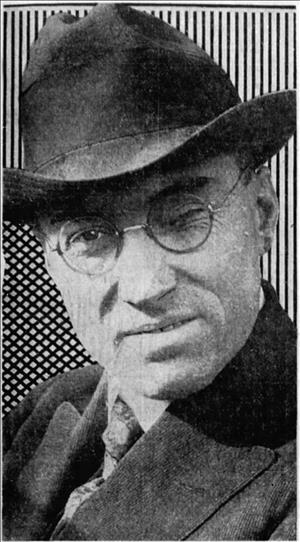A pioneer in the field of photojournalism, Frank Jacobs covered events big and small throughout the Pacific Northwest, but specialized in transportation disasters such as ship and train wrecks. Although he spent most of his career with the Seattle Post-Intelligencer, he also had stints with other publications, ran his own photography studio, served as an early motion picture cameraman for the Pathe News, and had the opportunity to photograph eight Presidents.
From the Circus to Seattle
Born in Kansas in 1881, at the age of 12 Frank Jacobs lost his left eye in a farm accident, fairly ironic for someone who would eventually make his living as a photographer. In 1895, at the age of 14, he did what many little boys dream of by running away and joining the circus. Jacobs worked as a roustabout with the Ringling Brothers organization for a single season, afterward settling in Illinois.
Eventually he worked his way west, and in 1907 Frank Jacobs put down roots in Seattle. One of his first local jobs was with the Owl Drug Company, but after only a few years he opened his own photography studio at 4th Avenue and Union Street. Jacobs had apparently been interested in photography since he was a boy, but it isn't clear how much (if any) formal training he had before opening the studio.
A Man of Action
In 1909, he began as a part-time photojournalist with the Post-Intelligencer, one of the first photographers ever hired by the paper. Although talent was certainly a prerequisite, Jacobs' stint also demonstrated the importance of being in the right place at the right time. "Newspapers didn't use many photographs in those days," he told a reporter in 1976. "They used line cuts. But I had a photography business in the PI building, so I did some work for the paper" (Evans).
His first assignment was to cover the Alaska-Yukon-Pacific Exposition, held on the University of Washington Campus in 1909. But where "Camera Eye" or "One-Eyed Jake" (just two of his nicknames) made his mark was covering disaster scenes -- train accidents, ship collisions, airplane wrecks, and the like.
In the process of covering these events, Frank Jacobs demonstrated that he could outhustle almost everyone to get "the shot." In 1910, Jacobs made his way to the town of Wellington in the Cascades, an effort to document the scene of a train that had been buried under a winter avalanche, claiming more than 100 lives. He arrived a full 17 hours ahead of colleagues from rival papers by persevering on foot for the last mile or so after the rail line became impassable. This included trudging up a 1,000 foot incline in near-blizzard conditions, his tripod and glass photographic plates slung over his shoulder." At the top of this hill we again reached the railroad tracks," he later said of the journey." The trail itself was not so difficult after that, but there [was] the ever present danger of death from new slides, which threatened at every moment" ("Photographers First to Enter Town of Death").
Jacobs' diligence paid off when he earned more than $1,000 for his exclusive photos, which were picked up by wire services from around the world. For yet another assignment, Jacobs -- at the time working for the Seattle Star -- became the first photographer to take aerial photographs of Seattle. In 1913, he strapped himself to the wing of a floatplane designed by H.P. Christofferson, took off from Madison Park and circled parts of Lake Washington, Kirkland, and Seattle at an altitude of 500 feet. "Over the Kirkland dock we were so high that I got nervous and touched Christofferson's shoulder," he confided afterward to a reporter. "[Not being able to hear me, Christofferson] grinned and nodded. He thought I wanted to experience a few maneuvers ... So he pulled a lever or something, and we dove straight down about 200 feet, and my stomach rose to the top of my head. Then we swooped up again, and my stomach dropped into my shoes" (Boalt).
Other photographic scoops relied less on derring-do and more on cunning. In one of his 1979 obituaries, the story was retold that he once rushed to the Seattle waterfront on his way to a maritime accident, only to find two boats available for hire. For Jacobs, the choice was simple. He hired both -- one to get him to the site of the wreck, and the other to cruise around Elliott Bay for a couple of hours so no other photographers could follow ("Former P-I Photographer Jacobs Dies at Age 97").
Still and Motion Photography
Sometime between 1911 and 1913, Jacobs bought his first motion picture camera, and spent the next few years supplementing his income as a local stringer for the Pathe News. According to Eastside historian Alan J. Stein, Jacobs not only shot newsreels for Pathe, but also provided local footage for the weekly newsreel produced by Seattle's Liberty Theatre.
In 1922, Jacobs also shot promotional footage for the Seattle real estate firm of Burke and Farrar, which was actively promoting its holdings in the Kirkland area. The company had already produced a motion picture extolling the idyllic life offered on the Eastside: The film, My Country, toured the Midwest in the early 1920s and seems to have been successful in attracting newcomers to the Pacific Northwest. It's not clear whether Jacobs was involved in shooting My Country, but he was eventually hired to shoot additional footage for later presentations.
From Promoting Real Estate to Selling It
Frank Jacobs seems to have abandoned photojournalism around 1925, concentrating instead on expanding his photography business. In 1945, health problems forced him to leave Seattle for Arizona, where he lived in several cities while pursuing a second career investing in real estate. He eventually settled in Tucson.
A resident of the Elks Nursing Home in Tucson during his final years, Frank Jacobs passed away on November 17, 1979, six weeks away from his 98th birthday.

